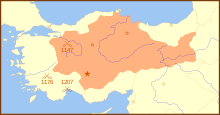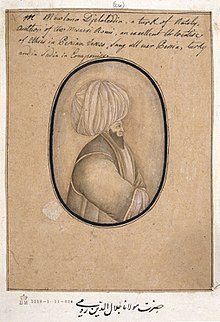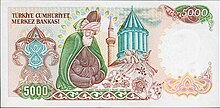Rūmī
Jalal ad-Din Muhammad Rumi - short Rumi (also Rumi wrote) called - (Total Name persian جلال الدین محمد بن شيخ بهاء الدين محمد بن حسين بلخى رومی, DMG Ǧalāl ad-Dīn Muḥammad bin Šaiḫ Bahā 'ad-Dīn Muḥammad bin Ḥusain-i Balḫī-yi Rūmī ), mostly called Maulawī (مولوی) in Persian (born on September 30, 1207 in Balch , today in Afghanistan , or Wachsch bei Qurghonteppa , now in Tajikistan ; died December 17, 1273 in Konya ), was a Persian Sufi mystic , scholar, and one of the most important Persian-speaking poets of the Middle Ages. From his followers, especially the dervishes , he was nicknamed Maulana ( Arabic مولانا, DMG Maulānā ; Turkish spelling: Mevlânâ , internationally also Mevlana ), "our Lord / Master" (from Arabic maulā ; cf. Mullah ). The Mevlevi Derwisch Order is named after him.
Life
Rumi's father, Baha ad-Din Walad, was a respected theologian in the historical region of Khorasan who, when his son was born, lived either in Balkh south of the Amu Darya or in the small town of Wachsh (Lewkand) north of the river and whose spiritual lineage was on Ahmad Ghazali is repatriated ; his paternal grandfather, Husain, was a noted scholar. According to an early and legendary biography, his paternal ancestry is said to be traced back to the caliph Abu Bakr , while his mother, Mu'mina, is said to have been the daughter of the Khorezm Shah Muhammad II .


Childhood and youth
When Rumi was a child, the Mongols invaded Balkh under Genghis Khan in 1219. His father had foreseen this, since the Khorezm Shah had some Mongol merchants killed and an act of revenge was to be feared. He and his family had already left the area to make a pilgrimage to Mecca . On the way there they met the well-known Sufi Farid ad-Din Attar in Nishapur , who was already an old man at that time.
Following the pilgrimage to Mecca , the family set off for Anatolia ( Rūm , hence the nickname Rūmī ), which was ruled by the Rum Seljuks at that time. During a stay in Laranda, today's Karaman , Jalal ad-Din's mother died; her grave is still a place of pilgrimage to this day. The family then moved to Konya. There Jalal ad-Din married his first wife Gauhar-Hatun (also Dschauhar Chatun), who had also fled from the east. In 1221 their first son Walad is born. Then in 1225, after the death of his first wife, Rumi married his second wife, Kira Chatum, who came from a Christian family; they had two children together.
education
The Seljuk Sultan Ala ad-Din Kai-Qubad I , who resided in the nearby city of Konya, heard of Baha ad-Din Walad's new whereabouts in 1228. Because he valued and promoted the sciences and philosophy, he wrote to him to offer him a residence and a professorship at the Madrasa (University) of Konya. Jalal ad-Din studied Islamic sciences there under his father and took over his chair after his father's death in 1230 or 1231.
Life path
He was introduced to Sufism by a murschid named Sayyid Burhanuddin Muhaqqiq Tirmidhi . Together they traveled to Aleppo and Damascus , where they are said to have met Ibn Arabi from Spain ( Murcia ), an influential Sufi master.
As a scholar, Maulana Jalal ad-Din (Rumi) achieved great fame, and he lived and acted as it should be traditionally for an established and highly respected scholar. It was only when he met the dervish Shams-e Tabrizi (also known as Shamsuddin Tabrizi) in Konya in 1244 that his life changed radically. Shams-e Tabrizi was himself a student of Hajji Baktasch Wali , who lived at the same time. Shams was a strong personality, endowed with great spiritual abilities. The spiritual bond between the two friends became so strong that Maulana (Rumi) temporarily renounced the world in order to devote himself entirely to the friend's secrets.
After the jealousy and envy of many influential Konyaans grew too great, Shams fled the city. Rumi's grief was great until one day Shams returned. Probably because after a while the situation became just as unbearable as before, shams disappeared forever. It is believed today that he was murdered. The longing for the friend inspired Maulana Jalal ad-Din (Rumi) to the round dance, which is still imitated today, and to compose his verses, which are also much cited to this day.
mausoleum
After his death, Maulana Jalal ad-Din was buried in a mausoleum, which the Maulawi Order (Turkish: Mevlevi ) then also served as a meeting place ( Tekke ). This mausoleum has been Konya's landmark ever since and has served as a place of pilgrimage for devout Muslims and Maulana's followers to this day. When Ataturk forbade public religious acts in the course of secularization on September 2, 1925 , the Mevlevi Order was also affected. Nevertheless, Jalal ad-Din's tomb did not lose its importance. It is a custom among the general population to buy small amulets in the shape of the tomb after visiting the mausoleum, which has been converted into a museum by the Turkish government.
The day of his death, December 17th, is traditionally marked with the şeb-i âruz ( Persian شب عروسى, DMG šab-i ʿarūsī , 'wedding night ') committed; Rumi called the day of his death a great wedding, as he would be united with God on it. The celebrations take place in Konya.
Works
- Rūmīs most important poetic work is his 25,700 lines of verse comprehensive Mathnawi with the title Ma s nawī-yi Maʿnawī . With reference to this work, the mystic Jami is said to have said of Maulana: "He is not a prophet, and yet he has a book?" Kamāl ad-Dīn Husain ibn-i Hasan-i Chārazmī (died approx. 1436) wrote a commentary on this work with the title Ǧawāhir al-asrār wa-zawāhir al-anwār , which was published in 2005 in Tehran by Muhammad Jawād Sharīʿat in four volumes was issued.
- Another major work by Maulana is the Diwan-e Schams-e Tabrizi ( The Diwan of Schams-e Tabrizi ; Schams-ad Din = Sun of Faith ), which contains 35,000 lines. This was created over a period of 30 years, from the disappearance of Shame to Maulana's death in Konya in 1273. Compared to the more sober Mathnawi , the divan more clearly reflects the feeling of mystical drunkenness.
- Comparable with the Mathnawi is the prose collection Fihi ma fihi (literally , there is what is in it ). These are lectures that he gave to his students; just like Madschalis-i Sab'a ( Seven Sessions ), which he held before the public before his meeting with Shams.
Teaching
Maulana's (Rumi's) teaching is based on the fact that he saw love as the main force of the universe . More precisely, the universe is a harmonious whole in which each part is in a love relationship with all the others, which in turn is directed solely to God and can only endure through his love.
Man, who is created as part of this harmonious whole, can only achieve harmony with himself and the universe if he learns to love God. His love for God will enable him to love not only his fellow human beings, but everything God has created.
For Maulana, as for most Sufis, coming closer to God through love is the way to true fulfillment in life. The reason for his fame is that he had the ability to translate this teaching into poetry .
The verses attributed to him, possibly incorrectly, express this understanding:
Come over! Come over! Who you are
If you are also an idolater or a fire worshiper.
Come back! This is the door of hope not hopelessness.
Even when you break your promises a thousand times.
Come over! Come back!
He described the joy of drawing closer to God with the same fluency as the sadness of having to be separated from God. Like other mystical poets, he referred to God as the beloved and the human soul in search of God as the lover .
His quatrains, which express life wisdom in short words, are also particularly well-known:
“Do you think I know what I'm doing?
That I belong to myself for a breath or a half?
No more than a pen knows what it is writing,
or the ball can guess where it is about to fly. "
A famous poem , which was translated into German by Friedrich Rückert (1788–1866), deals with the transformation process of human existence and recalls the Buddhist cycle of life , but also aspects of Neoplatonism .
UNESCO and its 800th anniversary
UNESCO has declared 2007 the year of 'Rumi-Balkhi'. On the occasion of his 800th year of birth, the world organization had a 'Rumi Balkhi' medal minted .
literature
Primary texts
- Divan
- Nevit Oguz Ergin (Ed.), California 2000 (based on the Turkish translation of Golpinarli)
- Arthur John Arberry : Mystical poems of Rumi, first selection, poems 1-200. University of Chicago Press, 1968; Ders .: Mystical poems of Rumi, 2: second selection, poems 201-400. University of Chicago Press.
- Reynold A. Nicholson : Selected Poems from the Divani Shamsi Tabriz. Cambridge 1898 selection ; S. Bogdanov: The Quatrains. In: JASB Volume 1, 1935, pp. 65-80.
- Mathnawi
- Arthur J. Arberry: Tales from the Masnavi. 1961; ders .: More Tales from the Masnavi. Shortened in 1963 , especially only the actual stories
- Jawid Mojaddedi: Rumi: The Masnavi. Book One, 2004 et seq . : Rumi: The Masnavi. Book Two, 2007 rhyming transfer
- Reynold A. Nicholson: The Mathnawí of Jalálu'ddín Rúmí (with English translation), London 1924–40 complete text; Volumes 7 and 8 with complete commentary
- Jalal ad-Din Rumi: The Song of the Flute. (Bilingual edition of the 51 verses of the table of contents of Mathnawi, with recitation.) Translated into German and provided with an introduction by Reza Maschajechi. Edited with an accompanying word by Uta Kutter. With CD. Recitation: Reza Maschajechi and Caroline Wispler; Music, vocal and instrumental: Alev Naqiba Kowalzik; Sound engineering: Alexander Noelle. Stuttgart: Academy for Spoken Word, 2010
- Jalal ad-Din Rumi: Masnawi - complete edition in two volumes . First volume: Book I – III, Xanten: Chalice, 2020, ISBN 978-3-942914-51-2 . Second volume: Book IV – VI, ISBN 978-3-942914-52-9 Complete text translated from Persian into German blank verses by Otto Höschle
- Erkan Türkmen: The Essence of Rumi's Masnevi: Including His Life and Works. 1992 selection, with Persian text and commentary
- Eva de Vitray-Meyerovitch: Mathnawi, de Jalâl ud Dîn Rûmî, avec de la collaboration de Jamshid Murtazavi. éd. du Rocher, 1990, ISBN 2-268-01041-4 full text in French translation
- EH Whinfield: Masnavi i Ma'navi: Teachings of Rumi: The Spiritual Couplets of Maulána Jalálu-'d-dín Muhammad i Rúmí. Trübner, London 1887 and reprints ( online ; PDF; 1.1 MB)
- Alan Williams: Rumi: Spiritual Verses: The First Book of the Masnavi-ye Manavi (= Penguin classics. ). Penguin, London 2006, ISBN 0-14-044791-1 Translated into iambic five-lifters
- Fihi ma fihi
- Annemarie Schimmel : Maulana Dschelaladdin Rumi: From All and From One, from Persian and Arabic. Munich 2008.
- Arthur John Arberry: Discourses of Rumi. J. Murray, London 1961, 1975, 1993; New York 1972. ( online ; PDF; 712 kB)
- Wheeler M. Thackston Jr .: Signs of the Unseen: The Discourses of Jalaluddin Rumi. Shambhala Publications, Putney VT 1994, ISBN 1-57062-532-8 .
- Other selection and reading issues
- The Essential Rumi. translated by Coleman Barks with John Moyne, AJ Arberry, Reynold Nicholson, San Francisco: HarperCollins, 1996, ISBN 0-06-250959-4 ; Edison (NJ) and New York: Castle Books, 1997, ISBN 0-7858-0871-X . Selected poems.
- Johann Christoph Bürgel: Jalaluddin Rumi: Dream image of the heart - one hundred quatrains . Manesse Bücherei Vol. 45, Zurich 1992, ISBN 3-7175-8196-1 .
- William C. Chittick : The Sufi Path of Love: The Spiritual Teachings of Rumi. 1983 thematically arranged selection from various works
- Ibrahim Gamard: Rumi and Islam : Selections from His Stories, Poems, and Discourses, annotated and explained, 2004
- Ali Ghazanfari (translator / interpreter), Ǧalāl-ad-Dīn Rūmī: summit of love. Selected quatrains by Rumi; Persian-German . Bilingual edition, Engelsdorfer Verlag, Leipzig 2009, ISBN 978-3-86901-171-4 .
- John O'Kane: Shams al-Din Ahmad-e Aflâkî: The Feats of the Knowers of God. 2002 early stories about Rumi
- Franklin D. Lewis: Rumi: Past and Present, East and West: The Life, Teachings and Poetry of Jalâl al-Din Rumi. Oneworld, Oxford 2003, ISBN 1-85168-335-6 . with translations of selected texts
- Franklin D. Lewis: Rumi: Swallowing the Sun. 2008 translations of selected texts
- Love mysticism: poems from the divan. in Dt. transfer by Reza Maschajechi. Verlag Bibliothek der Provinz , Weitra 2004, ISBN 3-85252-596-9 . In addition audio CD Liebesmystik: Poems from the divan , with music played by the Dohnányi Trio. Verl. Library d. Province, Weitra 2007, ISBN 978-3-85252-809-0 .
- Jalal ad-Din Rumi: Look! This is love: poems , selected and translated by Annemarie Schimmel. Basel: Sphinx 1993. New edition: Chalice, Xanten 2019, ISBN 978-3-942914-41-3 .
- Annemarie Schimmel: From the divan . Reclam, Philipp, jun. GmbH, Verlag (1986) ISBN 978-3150089118 .
- Annemarie Schimmel: Rumi: I am wind and you are fire: the life and work of the great mystic . Hugendubel, Kreuzlingen / Munich 2003. New edition: Chalice, Xanten 2017, ISBN 978-3-942914-19-2 . Selection from various works
Secondary literature
- Türkmen Erkan: The Essence of Rumi's Mathnevi. Misket 1992, ISBN 975-95630-0-2 . (engl.)
- Helmut Ritter , A. Bausani: Ḏj̲alāl al- Dīn Rūmī b. Bahāʾ al-Dīn Sulṭān al-ʿulamāʾ Walad b. Ḥusayn b. Aḥmad Ḵh̲aṭībī. In: P. Bearman, Th. Bianquis, CE Bosworth, E. van Donzel, WP Heinrichs (eds.): Encyclopaedia of Islam . [3]
- William Chittick (Ed.): Shems-i Tabrizi: Me and Rumi, The Autobiography of Shems-i Tabrizi. Foreword by Annemarie Schimmel, Louisville. Fons Vitae, Kentucky 2004. Brief Review
- Herbert Hopfgartner: Listen to the innumerable tones with the ear of the soul. Musical notes on the mystic Jelaleddin Rumi. In: Talk Togethet. No. 21, Salzburg 2007 (www.talktogether.org)
- Annemarie Schimmel: Rumi: I am wind and you are fire. Life and work of the great mystic Diederichs Verlag, Munich 1978 (new edition by Chalice, Xanten 2017, ISBN 978-3-942914-19-2 ).
Web links
- Biography and works of Rumi (with German translations)
- Literature by and about Rūmī in the catalog of the German National Library
- Works by and about Rūmī in the German Digital Library
- Mevlana.ch - International Mevlana Foundation (German)
- Works by Rūmī at Zeno.org .
- Works by Rūmī in the Gutenberg-DE project
- Ghazels of Jelal-eddin Rumi . Editor Friedrich Rückert . Stuttgart 1922 online - Internet Archive
- Choice from the divans . Translator / editor Vincenz von Rosenzweig, Vienna 1838 online - Internet Archive
- Moulana Rumi - Poems (German, Persian)
- Why is the rose laughing? Three poems by Rumi (German)
- Film about Rumi (German, Persian, English)
- Film about the Semâ ceremony of the Mevlevi dervishes in Zurich in 1989 (English, German)
- Erkan Turkmen: Essence of Rumi (English brief information)
- Ibrahim Gamard: Dâru 'l-Masnavî (Persian text and commented English translation of passages from Mathnawi and Diwan)
- Manuchehr Jamali: a recontextualization of Rumi's metaphors in the ideas of ancient Iranian culture (PDF; 120 kB)
- Annemarie Schimmel: Rumi: Music and dance - the circling of the worlds
- Rumis Masnawi (excerpts from the German translation of verse by Otto Höschle)
- Selected bibliography
References and comments
- ^ Franklin Lewis: Rumi: Past and Present, East and West. The Life Teachings and Poetry of Jalâl al-Din Rumi. One World Publications, Oxford 2000, p. 47.
- ↑ Annemarie Schimmel: Rumi - I am wind and you are fire . Kreuzlingen / Munich 2003, p. 9.
- ↑ Jalal o'd Din Rumi: Poems of Sam from Tabriz: (selection). Reprint Mechitaristen-Congrations-Buchhandlung, Vienna 1838, translated by Vinzenz Rosenzweig von Schwannau , BoD Books on Demand, Norderstedt 2017, ISBN 978-3-84304-823-1 , p. 90
- ↑ Annemarie Schimmel: Rumi - I am wind and you are fire , p. 8
- ↑ lit. Translation: The jewels of secrets and the apparitions of the shine of lights .
- ↑ Maulana Dschelaleddin Rumi - From All and From One , from d. Pers. u. Arab. by Annemarie Schimmel, Munich 1988, p. 8
- ↑ Yakup Şafak: Mevlânâ'ya Atfedilen “Yine Gel…” Rubâîsine Dair in Tasavvuf ilmî ve akademik araştırma dergisi 24 [2009/2], pp. 75–80 [1]
- ↑ Murat Bardakçı: Şoka gel şokaaa! , Habertürk, December 28, 2012; accessed on June 22, 2014 [2]
- ↑ Gerhard Riemann (Ed.): Dschelalledin Rumi, Open Secret. Munich 1994, p. 42.
- ↑ Archived copy ( memento of the original dated June 29, 2009) Info: The archive link was inserted automatically and has not yet been checked. Please check the original and archive link according to the instructions and then remove this notice.
| personal data | |
|---|---|
| SURNAME | Jalāl ad-Dīn ar-Rūmī |
| ALTERNATIVE NAMES | Jalal ud-Din Muhammad-e Balkhi; Maulana (Persian); Mevlana (Turkish); Rumi |
| BRIEF DESCRIPTION | Islamic mystic, founder of the Mevlevi dervish order |
| DATE OF BIRTH | September 30, 1207 |
| PLACE OF BIRTH | Balch |
| DATE OF DEATH | December 17, 1273 |
| Place of death | Konya |



